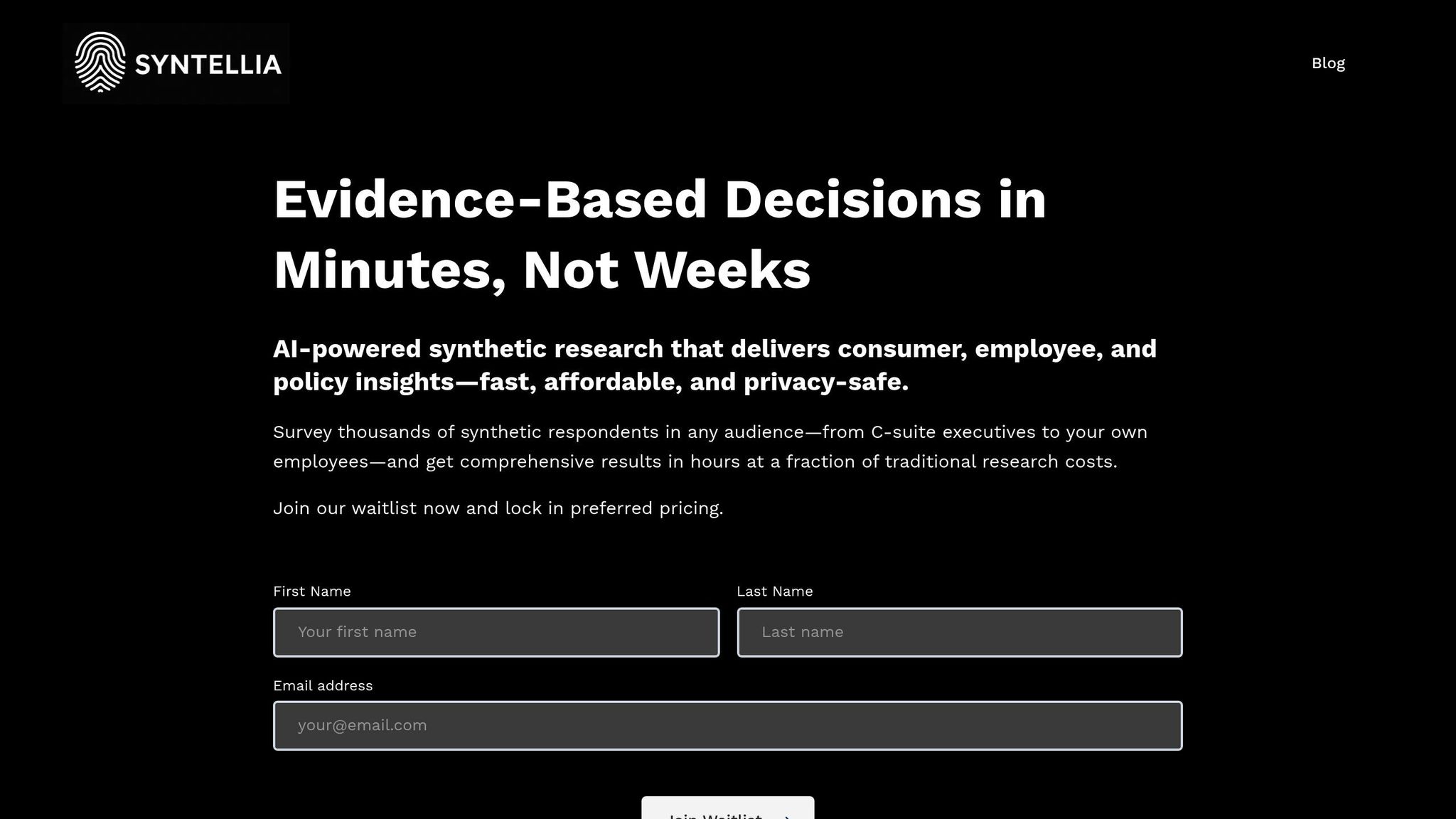Synthetic research is transforming how we study hard-to-reach audiences like rare disease patients, C-suite leaders, or specialized experts. Instead of relying on traditional methods, it uses AI to create virtual respondents that mimic real-world behaviors, demographics, preferences, and decision-making patterns. This approach tackles challenges like low response rates, high costs, privacy issues, and geographic barriers.
Key Takeaways:
- What It Solves: Engages niche groups that are hard to study due to rarity, privacy, or accessibility.
- How It Works: AI builds synthetic personas from existing data, simulating responses with 90% behavioral accuracy.
- Benefits: Faster insights, lower costs, privacy protection, and scalable research for complex or sensitive groups.
- Limitations: Requires careful validation, may miss emotional depth, and struggles with compliance in regulated industries.
By using platforms like Syntellia, organizations can gather insights in minutes, saving time and resources without compromising on quality. This method is reshaping research for industries needing precise, fast, and confidential data collection.
Understanding Hard-to-Reach Groups
What Defines Hard-to-Reach Groups?
Hard-to-reach groups are those that are difficult to engage due to specific circumstances or environments. These challenges can stem from geographical isolation, technological barriers, or sociocultural factors that prevent them from participating in traditional research methods.
"In market research, some audiences remain difficult - if not impossible - to reach using traditional sampling methods. Whether due to geography, rarity, sensitivity, or timing, certain segments simply fall outside the scope of feasible recruitment." - Madalina Mirigel, DataDiggers Blog
The characteristics of these groups vary, but they share common challenges that make them elusive. For example, rural seniors often lack access to high-speed internet, making online surveys inaccessible. Similarly, engaging C-level executives in niche B2B industries can be challenging due to their professional exclusivity. Early adopters of pre-market technologies are another tricky segment to reach, as their numbers are small and constantly changing.
Medical and vulnerable populations pose additional hurdles. Rare disease patients, for instance, are so few in number that traditional methods struggle to gather statistically significant sample sizes. Other examples include political extremists, immigrants with language barriers, and individuals in crisis situations, such as those in homeless shelters or war zones. Even prospective employees—especially those in high-demand fields, passive job markets, or underrepresented communities—can be difficult to reach through conventional recruitment efforts. These groups often remain outside the reach of conventional recruitment efforts.
Barriers to Engaging Hard-to-Reach Groups
Several practical challenges make engaging these groups even tougher. Language barriers are a significant issue, particularly for migrant populations. A 2020 study highlighted how surveys across Europe frequently exclude migrants because of language eligibility requirements.
Digital access is another major hurdle. Many rural or low-income communities lack reliable internet connections or the digital literacy needed to participate in online research. Additionally, institutional and legal restrictions can limit access to certain groups. For example, some populations are protected by regulations or face local access constraints that make traditional survey methods ineffective. These barriers not only reduce the number of participants but also compromise the quality of insights, making it harder to achieve accurate representation.
Why Accurate Representation Matters
Filling these representation gaps is essential for effective research and decision-making. When hard-to-reach groups are excluded, it creates blind spots that can mislead business strategies and public policies. If a research sample doesn’t reflect the broader population, the insights drawn from it are likely to be skewed and unreliable.
For businesses, failing to capture input from niche but influential segments can result in missed opportunities. For instance, a single decision-maker in a large corporation might control significant purchasing power, yet their perspective often goes unrepresented in standard studies. Similarly, early adopters of new technologies can provide critical feedback on product-market fit, but their small and shifting numbers make them challenging to study.
In healthcare, overlooking rare disease patients can delay advancements in treatment. Policies that fail to account for the needs of immigrant communities or rural populations risk neglecting critical issues. Ultimately, incomplete or biased data can lead to costly mistakes, from poorly executed product launches to ineffective marketing campaigns. Addressing these gaps is not just about inclusion - it’s about ensuring that decisions are based on accurate and comprehensive insights.
How Synthetic Research Addresses Hard-to-Reach Groups
What Is Synthetic Research?
Synthetic research is a modern approach to market research that leverages AI to create virtual respondents. Instead of recruiting real participants, this method uses AI-driven personas to simulate the responses of actual individuals. By analyzing existing data, these AI models build virtual profiles that mirror the behaviors, preferences, and decision-making processes of specific audience segments.
One of the standout features of synthetic research is its ability to scale. Traditional research often struggles to find participants from rare or niche demographics. Synthetic research, however, can generate a large pool of virtual respondents, making it possible to study groups that would otherwise be difficult - or even impossible - to reach. This scalability opens up new possibilities for research, improving both efficiency and precision.
Benefits of Synthetic Research
When it comes to studying hard-to-reach groups, synthetic research brings several advantages to the table:
- Speed: Insights are generated quickly, allowing researchers to test multiple ideas in less time.
- Cost savings: By eliminating the need for expensive recruitment and long timelines, synthetic research significantly reduces costs.
- Improved privacy: Since the research relies on AI-generated personas and not real people, the risk of confidentiality breaches is greatly minimized. This is especially crucial when studying sensitive or vulnerable populations.
- Consistency: Unlike human participants, whose responses can be influenced by external factors, synthetic personas provide stable and uniform characteristics. This consistency ensures more reliable findings and reduces variability.
These advantages highlight the efficiency and reliability of synthetic research, especially when working with populations that are traditionally difficult to access.
The Role of Synthetic Personas
Synthetic personas are the foundation of synthetic research. These AI-generated profiles combine demographic, psychological, behavioral, and even social traits to create a comprehensive representation of specific groups.
For example, a synthetic persona designed to represent rural seniors might include details like age, geographic location, healthcare concerns, financial habits, and social values. This level of detail allows researchers to better understand the unique challenges and preferences of this group.
The flexibility of synthetic personas is another major strength. Researchers can use them to study complex, overlapping identities that are hard to capture through traditional recruitment. For instance, a persona could represent someone who is a first-generation immigrant, a small business owner, and a caregiver for a child with special needs - an intersection of traits that would be nearly impossible to recruit for in a traditional study.
Additionally, synthetic personas can evolve over time. They can be updated to reflect shifts in attitudes, behaviors, or societal trends, making them ideal for long-term studies without the logistical hurdles of maintaining real participant engagement. This adaptability ensures that research remains relevant and reflective of current realities.
Step-by-Step Guide to Emulate Hard-to-Reach Groups
Starting with synthetic research for niche audiences involves a clear, methodical approach. These steps outline how to emulate hard-to-reach groups and derive meaningful insights. The process begins by narrowing down and defining your target audience.
Step 1: Define Your Target Audience
The first step is to pinpoint your target group by analyzing their demographics, psychographics, and behaviors. Focus on what makes them hard to reach in the first place.
Start with demographics: age, income, location, education, employment, and more. For instance, if you're studying rural healthcare workers, note their geographic distribution and varying levels of expertise.
Then, dig into psychographics - values, beliefs, lifestyle choices, and motivations. Rural healthcare workers, for example, might prioritize community service and have unique concerns like professional isolation or limited resources compared to their urban counterparts.
Behavioral traits are equally critical. How do they make decisions? What shapes their habits? For rural healthcare workers, this might mean relying on peer networks, prioritizing practical solutions, and basing purchasing decisions on cost-effectiveness rather than brand recognition.
Lastly, identify the barriers that make this group challenging to study - geographic isolation, time constraints, privacy concerns, or skepticism toward research. These obstacles highlight why synthetic research is so useful for these audiences.
Once you've defined your audience, you're ready to create detailed synthetic personas in the next step.
Step 2: Build Synthetic Personas
With a clear understanding of your audience, the next step is to create virtual profiles that represent this group. These synthetic personas should reflect the diversity and complexity of your target audience.
Start by establishing core identity markers based on the demographic traits you outlined earlier, but ensure enough variation to capture the group's diversity. For example, if you're studying military veterans transitioning to civilian careers, include differences like service branches, deployment experiences, and transition timelines.
Incorporate key personality traits, thought patterns, and emotional drivers. Consider how their experiences shape decision-making. For veterans, this might involve a strong focus on risk assessment, a preference for structured environments, and an emphasis on loyalty in professional relationships.
Add contextual details that reflect their daily lives - routines, social connections, and external constraints. A veteran entering the civilian workforce might rely on veteran-specific job boards and value employers who understand military experience.
Finally, address intersectionality within your group. Real people have overlapping identities that influence their behavior. For instance, a female veteran may face different challenges than her male counterparts, and these nuances should be reflected in your personas.
With these personas in place, you can move on to designing research tools in Step 3.
Step 3: Design and Deploy Research Instruments
Creating effective research tools for synthetic studies involves tailoring them to how your audience communicates and processes information. The goal is to align the tools with the personas you've developed.
Craft questions that match your audience's communication style and expertise. Avoid jargon they might not understand, but don't oversimplify if they're knowledgeable in their field. For example, when studying rural small business owners, use clear business terminology and avoid overly complex financial language.
Design scenarios that mirror real-world situations for your audience. Instead of generic examples, create contexts they encounter daily. A rural small business owner might evaluate suppliers based on delivery reliability and personal relationships rather than just price or features.
Use an AI-powered platform, like Syntellia, to deploy your research instruments. These platforms can simulate the decision-making patterns of your synthetic personas, providing insights in minutes rather than weeks. They also allow you to test multiple versions of your tools simultaneously, experimenting with different question formats, scenarios, or persona variations to find the most effective approach.
Once your instruments are deployed, the next step is to refine and validate your findings.
Step 4: Iterate and Validate
This step involves refining your approach and ensuring your findings align with real-world data. Iterative cycles help fine-tune the accuracy of your personas and research instruments.
Start by analyzing the initial results for patterns that match the traits you identified in Step 1. For example, if you're studying freelance creative professionals, look for responses that reflect concerns about income stability, project-based thinking, and creative independence.
Validate your findings using reliable data sources like industry reports, census data, academic studies, or even trends on social media. While perfect validation isn't always possible, these reference points can confirm whether your synthetic personas are generating realistic responses.
Refine your personas based on unexpected or inconsistent results. If the responses don't align with what you anticipated, consider whether your personas need adjustments or if you've uncovered new insights about your audience.
Adjust your research tools to improve clarity and relevance. Modify questions, contexts, or formats if certain elements produce unclear or inconsistent results. Since synthetic research allows for quick iterations, refining your approach is faster and more cost-effective than traditional methods.
Finally, run follow-up studies with improved personas and tools. This iterative process helps confirm patterns, explore new questions, and deepen your understanding of hard-to-reach groups. By continually refining your methods, you can build a comprehensive and reliable understanding of your target audience.
sbb-itb-2b2bc16
Pros and Cons of Synthetic Research for Niche Segments
Synthetic research has its strengths and weaknesses, especially when applied to hard-to-reach groups. Knowing both sides is crucial for deciding when and how to use this method effectively.
Key Advantages of Synthetic Research
Synthetic research offers several benefits that make it a compelling choice for certain projects:
- Speed and efficiency: Insights are delivered much faster compared to traditional research methods, allowing for quicker hypothesis testing and adjustments.
- Cost savings: It provides similar insights at a fraction of the cost, eliminating the need for extensive recruitment and outreach efforts.
- Scalability: Easily adjusts to projects of any size without the logistical hurdles of traditional recruitment.
- Privacy protection: Reduces confidentiality risks - ideal for studying sensitive groups like healthcare professionals or military personnel.
- Access to restricted groups: Makes it possible to study populations that are otherwise inaccessible due to security clearances, geographic isolation, or institutional barriers.
Potential Limitations
Despite its advantages, synthetic research has some notable challenges:
- Validation requirements: Findings must be cross-checked with external data to ensure accuracy, which can require extra time and expertise.
- Training data limitations: If the source data doesn’t adequately represent certain subgroups or recent trends, the research may miss key nuances or perpetuate biases.
- Limited emotional insight: While effective for identifying decision-making patterns and preferences, it may fall short in capturing deeper emotional drivers or subconscious motivations.
- Contextual complexity: Real-world decision-making often involves competing factors and social influences, which can be difficult to fully replicate in synthetic models.
- Regulatory acceptance: In industries with strict compliance standards, synthetic research findings might not meet the requirements for regulatory submissions or official decisions.
Comparison Table: Advantages vs. Limitations
| Advantages | Limitations |
|---|---|
| Speed: Delivers results faster than traditional methods | Validation: Requires external data verification |
| Cost: More affordable compared to conventional approaches | Training bias: Can reflect gaps in source data |
| Privacy: Reduces risks tied to confidentiality | Emotional depth: Lacks insight into subconscious drivers |
| Scale: Handles large sample sizes with ease | Regulatory: May not meet compliance standards |
| Access: Reaches hard-to-study populations | Complexity: Struggles with replicating real-world nuances |
| Iteration: Supports rapid testing and refinement | Novelty: Less effective for entirely new scenarios |
Ultimately, the choice to use synthetic research depends on your project’s priorities. If speed, cost-effectiveness, and privacy are top concerns, synthetic research can be a powerful tool - just be prepared to invest additional effort in validation to ensure robust results.
The Syntellia Approach: Simplifying Synthetic Research

Syntellia has created a platform that makes synthetic research not only easier but also faster to implement. While synthetic research is incredibly useful for studying groups that are difficult to access, many organizations find its complexity to be a hurdle. Syntellia tackles this issue head-on by offering a user-friendly system that doesn’t require deep technical expertise. This means teams can now gather precise insights from hard-to-reach groups without the usual challenges.
AI-Powered Synthetic Respondents
At the heart of Syntellia’s platform are its AI-powered synthetic respondents, which boast an impressive 90% behavioral accuracy when replicating real-world audiences. These virtual respondents are designed to mimic the decision-making processes, preferences, and behaviors of specific groups, eliminating the need to directly engage with individuals.
Using advanced behavioral modeling, the system generates responses that align with the characteristics of the target group. Whether you’re looking to study C-suite executives, healthcare professionals, or military personnel, these synthetic respondents provide reliable and nuanced insights. Unlike traditional persona development, which often involves guesswork, this approach ensures a more accurate representation of the group being studied.
These virtual respondents can also tackle complex scenarios and intricate questions, making them particularly effective for examining groups with specialized expertise or unique decision-making patterns. For instance, they are ideal for researching niche professional sectors or specific cultural communities that would otherwise require lengthy relationship-building efforts to access.
Rapid and Cost-Effective Insights
Traditional research methods often come with hefty price tags - ranging from $50,000 to $250,000 - and take anywhere from six to twelve weeks to complete. In contrast, Syntellia delivers comparable insights in just 30 to 60 minutes at a fraction of the cost, cutting expenses by as much as 90%.
This speed is especially critical when dealing with time-sensitive issues or rapidly changing market conditions. With Syntellia, organizations can test different messaging strategies, validate their plans, and adjust their approach in real-time instead of waiting weeks for traditional research results.
The platform also offers tiered annual SaaS subscriptions, removing the need for per-study fees. This allows users to conduct unlimited research within their subscription plan, making it financially feasible to frequently study hard-to-reach groups. Teams can quickly test ideas, refine strategies, and gain deeper insights without worrying about budget constraints. The result? Faster decision-making and the ability to scale research efforts more effectively.
Privacy and Scalability Advantages
When studying sensitive or hard-to-reach populations, privacy concerns often pose a major barrier. Syntellia eliminates this issue entirely by relying on zero real respondents, which removes all privacy risks. This is particularly beneficial for researching groups like government officials, healthcare workers handling confidential data, or employees in tightly regulated industries.
The platform provides access to a virtually unlimited pool of audiences and includes a comprehensive suite of tools for research, such as surveys, focus groups, conjoint analysis, and A/B testing - all accessible within a single interface. Whether you’re gathering insights from rural healthcare providers, global business leaders, or highly specialized technical experts, Syntellia’s synthetic approach removes participation roadblocks. Plus, it enables multi-method research without needing to juggle multiple vendors or platforms.
Another standout feature is the platform’s real-time iteration capability, which lets researchers adjust questions, tweak scenarios, and explore new directions as insights come to light. This flexibility is invaluable when studying groups that are complex or not well understood, as it allows researchers to refine their approach based on early findings.
Conclusion: Getting Insights with Synthetic Research
Synthetic research has revolutionized the way companies gather insights from niche or hard-to-reach groups. What once took months of effort can now be achieved in as little as 30 to 60 minutes. This rapid turnaround not only saves time but also tackles challenges like privacy concerns and high costs.
By eliminating the need for real respondents, synthetic research sidesteps the logistical and ethical hurdles of traditional methods. AI-driven virtual respondents, designed to closely mimic human behavior with 90% accuracy, offer a reliable alternative for uncovering insights that previously required lengthy and expensive studies.
The ability to deliver actionable insights in under an hour - at a fraction of the cost - is a game-changer. This streamlined approach allows organizations to make faster strategic decisions while continuously refining their research methods in real time. The result? A more agile and responsive research process.
Take Syntellia, for example. This platform combines privacy protection, scalability, and speed, offering researchers the ability to explore populations that were once considered inaccessible. Insights that seemed out of reach are now just minutes away.
For organizations aiming to understand niche audiences, synthetic research provides a fast, precise, and cost-effective solution. It’s a breakthrough that’s reshaping the future of research.
FAQs
How does synthetic research deliver accurate insights compared to traditional methods?
Synthetic research excels at delivering precise results by crafting data-driven models that mimic the behaviors and traits of actual populations. These models are developed by analyzing patterns and relationships within original datasets, allowing researchers to simulate specific or hard-to-access groups without needing direct access to sensitive or restricted information.
The reliability of synthetic insights hinges on the quality and diversity of the data used to train the AI. By addressing biases and including a wide range of perspectives, synthetic research offers dependable insights that are both practical and efficient, all while being mindful of costs.
What ethical concerns should be considered when using AI-generated synthetic personas for research?
When working with AI-generated synthetic personas, there are several ethical issues to keep in mind. One of the main concerns is the presence of hidden biases within AI models. These biases can skew the accuracy of simulated responses and raise questions about fairness. Another challenge is the potential for over-reliance on these personas without proper validation, which could lead to flawed insights or decisions.
Transparency plays a crucial role in addressing these issues. It's important to clearly disclose when synthetic data is being used and ensure that all stakeholders are aware of its limitations. Without transparency, trust and accountability can quickly erode.
Synthetic personas also carry the risk of unintentionally reinforcing stereotypes or biases, particularly around sensitive topics like socioeconomic status, race, or political beliefs. To tackle this, consider bringing a diverse set of perspectives into the research process. Collaboration and regular monitoring of AI models can help identify and reduce biases, making the personas more reliable over time.
How can synthetic research adapt to reflect fast-changing trends or underrepresented groups in data?
Synthetic research uses AI to create insights from virtual respondents, offering a powerful way to track rapidly changing trends or gain a better understanding of niche, hard-to-reach audiences. By producing data that mirrors new behaviors and preferences, it allows businesses to test ideas, adjust strategies, and make decisions with speed and precision.
This method shines when traditional research methods fall short - like when trends shift too quickly or when existing data fails to represent specific demographics or consumer groups. Synthetic research helps you stay on top of emerging trends and ensures your strategies are built on current, relevant insights.


